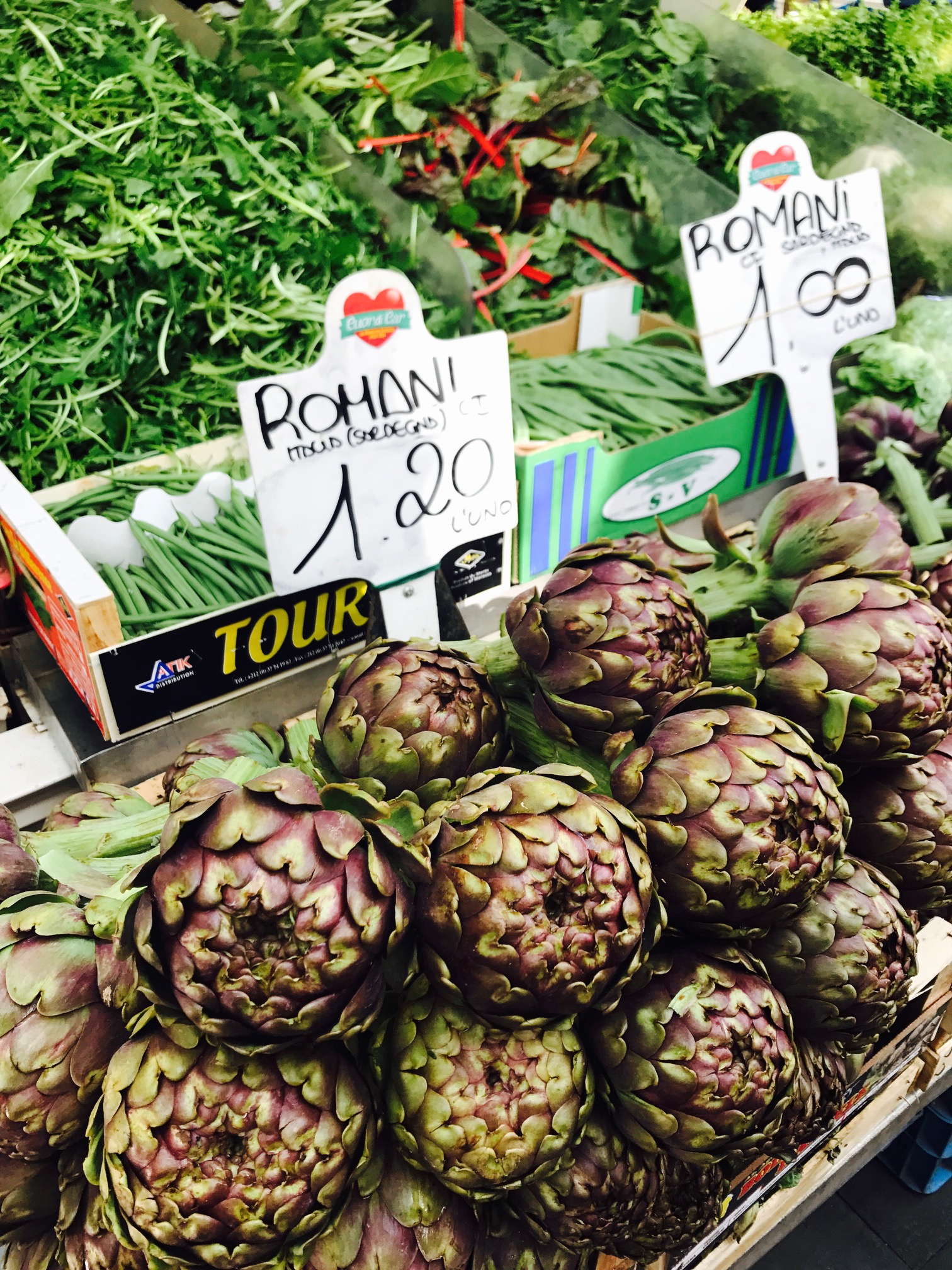"Always add the rosemary to the top of the focaccia after it has baked," says Carla Tomasi " or the essential oils will turn bitter in the heat of the oven." Tomasi - chef, baker, cookery teacher and erstwhile London restaurateur - proves the point that Italy's wondrously salty, olive-oil drenched flatbread is theoretically easy to make, but true deliciousness lies in the detail.
I'm in the light-drenched Latteria Studio in the Trastevere district of Rome, for the Market to Table event run today by Carla and food writer Rachel Roddy. It's not a cooking lesson as such, more a celebration of Roman cuisine and a chance for visitors to this glorious city to learn about its food, cook together and share a wonderful meal.
The day starts at the Testaccio Market; I've never been here before but I feel I know it well through Rachel's writing. This is her much-loved local market, almost a vibrant, bold character in its own right in her award-winning cook book Five Quarters. We fill our bags with produce, swoon over towers of sculptural artichokes and discuss the best way to cook chickpeas with a shopkeeper (a pinch of bicarb and much soaking).
Then we walk back across the river to Trastevere, past the Monte Testaccio hill, composed of 53 million broken amphorae, the terracotta vessels used in antiquity to hold grains and other foods, that were broken up and disposed of in this enormous dumpsite. On we go, winding our way through Testaccio's disused abattoir, once the largest in Europe, which gave rise to the district's tradition for offal-based dishes like trippa alla romana and oxtail stew. Across the Fiume Tever or the River Tiber, and we arrive at the beautiful little studio run by food stylist Alice Adams, where Carla has made us cinnamon rolls and coffee, and made a head start on the focaccia dough.
For me, the joy of the day lies as much in the cooking, prepping and discussing food communally, as it does in the learning: too many hours, I suppose, alone in the kitchen testing recipes with zip for company but Radio 4. And as Rachel says, many hands make otherwise onerous kitchen tasks easy. I would rarely contemplate making Alici impanate e fritter (fried anchovies) at home - the gutting, deboning and preparing the tiny silver fish, the most adored on the Roman table, just seems too much for one cook. And so it goes. Making fresh pasta seems fluid and simple with many shoulders to the wheel, while prepping vegetables - including a mountain of violet streaked artichokes - and other bites, seems not to much a job as a pleasant task with a soothing rhythm.
Not only have I learned the best way to bake focaccia, make pasta and prepare anchovies and artichokes - but rediscovered that many hands make light and joyful work in the kitchen. Let there be more communal cooking in my life.
For information about Market To Table days visit Latteria Studio or keep an eye on Rachel's blog or Instagram feed @rachelaliceroddy, or Carla's Instagram feed @tomasi_carla.
Carla's Focaccia e focaccine
There are endless recipes for focaccia out there in the wild, so mine is not the definitive article, but this makes me happy and ticks all the right boxes. Light/airy/bouncy/soft crumb/keeps and freezes well. So here it is.
Oven temp. 190c. For a focaccia not too thick, bake it in tin 34 cm across. Quantities can be easily halved or bake in two smaller tins. One for now and one for later.
200 gr plain flour
200 gr strong bread flour
1 teaspoon of fast action dry yeast
1 teaspoon of fine salt
1 tablespoon extra virgin olive oil
300 gr of tepid water Note: Measure the full amount but never add it all at once because the variants of the ability of flour to absorb liquid are many. Dry or wet flour/cold or hot day/ controlled environment or open windows and so forth..
Method
Place flours, yeast and salt in a suitable mixing bowl and swirl around. Drizzle in the olive oil and then pour in the water. Maybe on a very cold day the water temperature ought to be on the warm side of tepid and never mix your dough in a metal bowl. The dough will chill and stop working (just like you when you get a cold). Plunge one hand in and use it as if it is the (kenwood) K beater. As you go around the bowl, gather flour from the side towards the center. Once all the flour has been incorporated, pat into a shaggy mass, cover with a cloth and leave to rest for at least 15 minutes. Do not worry if the dough feels sticky, it will be fine.
When resting time is over the dough will feel soft and pliable. Pour a little olive oil on the work surface and plop the dough on it. Flatten it out gently and then pull the dough from the edge towards the center and every time give it a quarter turn. Pull the dough four times. Upturn the mixing bowl over the dough and again leave to rest for about 15 minutes. Repeat this process twice more. Now gather the dough into a ball and leave to prove ( around45 minutes) in an oiled plastic bowl. When the dough is ready ease it gently out of the bowl and onto an oiled baking tray. Leave to rest until the dough has relaxed( approx.15 mins) Try to finger massage the dough into shape and if it feels like springing back leave to rest for a while longer.
Once the dough has been spread out leave to rise ( preferably uncovered) well away from droughts or direct heat. If the day is really hot you may need to cover it. Could take from 40 mins to 1 hour. If a thin skin forms on the surface of the dough it is fine, it will be easier to brush it with olive oil.
When well puffed up- you know what I mean-gently dimple the surface with your fingers and brush lightly with oil. Pop into the very hot oven and rotate the tin at lest once. Takes around 20/ 25 minutes to bake but much depends on your oven.
I would strongly advise against baking the focaccia with any herb strewn on the surface, especially rosemary because the essential oil within the herb will turn bitter due to the strong heat. For a real taste sensation chop some rosemary needles finely and shower the focaccia as soon as it is out of the oven. Boom! Focaccia freezes really well( so make two)and wedges can be reheated in the toaster quickly because of the porous crumb structure.
I often like to make focaccine with various toppings and they are very easy to prepare. The above quantity of dough will be enough for 4 focaccine of 20-22 cm diameter or you could make them thinner if you wish. After the first rise split the dough in four and gather into balls. While the dough relaxes prepare the toppings. Finely slice one red onion and place in a little bowl with olive oil and thyme. Very thinly slice a small potato and toss with olive oil. Mix a couple of tablespoons of grated cheese, like parmigiano or grana, with quite few grindings of black pepper. Very finely chop some rosemary and set aside. When the dough is soft and pliable again roll it or pat it out into rounds. Place them on an oiled surface- like an oven tray or individual small tins and leave to rise till nicely puffed up and then place the toppings on. May need a drizzle of oil and some salt sprinkled on. They usually bake in around 10/12 minutes.





